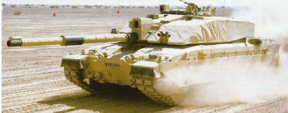| � � � � � |
By the beginning of the twentieth century the battleship had evolved into a more or less stereotyped form that was common to all navies - a steel ship of around 17,000 tons, armed with four big guns (usually around 300 mm) in two turrets, and up to forty smaller guns, ranging from about 230 mm to small quick-firing guns, protected along her sides and around her turrets by about 300 mm of hardened steel, and propelled by engines which produced a maximum speed of 18 - 19 knots. Because of the mentioned characteristics these ships were known as "mixed - armament" ships.
In the early years of the new century the British naval supremacy was threatened. It began in 1903. with an article in Jane's Fighting Ships, by Vittorio Cuniberti, who was a famous warship designer. Under the title "An Ideal Battleship for the British Navy", he outlined a design for a battleship of about 17,000 tons, carrying twelve 305 mm guns, protected by 300 mm armour, and capable of steaming at 24 knots. The basis of his argument for such a radical departure in battleship design was that her twelve 305 mm guns could bring a devastating volume of fire at long range. The one great disadvantage was that the introduction of this powerful battleship would make all the mixed - armament battleships obsolete. British naval supremacy, which was based on numbers, would be removed at a stroke, and she would have to start rebuilding her fleet from a scratch together with other countries.
Yet, even before Cuniberti's article, Britain was already beginning to move towards this new conception of battleship design, though with different reasoning. In 1903 the fighting range of ships was still around 3000 m. British Admiral Sir John Fisher experimented with much longer ranges. He thought that the battleship's fighting range should be around 6000 m or even up to 7500 m. At this range, the only reasonable method of achieving accurate gun control was by firing salvoes, and, since it was impossible to distinguish between the splashes made by 305 mm and 240 mm shells, corrections to range and direction were made for the salvo as a whole. If some of the shells fell short and some beyond the target, it was likely that at least one would hit it. But if all the guns were of the same calibre, the likelihood of one shell hitting the target was increased, and exactly the same corrections to the elevation of the gun would apply to all. Thus, for its own reasons, the British navy was coming round to Cuniberti's point of view.
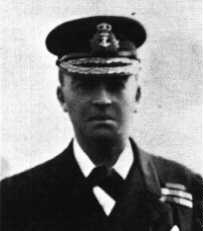 Admiral John Fisher
Admiral John Fisher
In 1904 Fisher was appointed to the Admiralty as First Sea Lord, and thus principal naval adviser to the government. He had made up his mind that the new type of battleship was essential if Britain was to retain her naval supremacy, simply because other navies would build them if Britain did not. If Britain would start building these new ships first, her proven ship-building capacity would ensure victory in any numerical race that might follow. Fisher wasted no time, and the keel of H.M.S. Dreadnought was laid at Portsmouth dockyard on October 2nd 1905. She was launched just four months later, on February 10th 1906, and was ready for trials on October 3rd 1906. She was completed in such a short time because of the usage of materials and components prepared for other ships. She joined the fleet in December of that year. She was 160 m long, 25 m wide and her draught was 8.2 m. The armament comprised ten 305 mm guns in five turrets, twenty - four 12-pounders (to repel the possible attack by torpedo boats), five machine guns and five 457 mm torpedo tubes. Her armour protection was 280 mm belt, barbettes and conning tower, and 102 mm deck. She had a displacement of 17,250 tons, a speed of 21 knots, and a complement of 729.
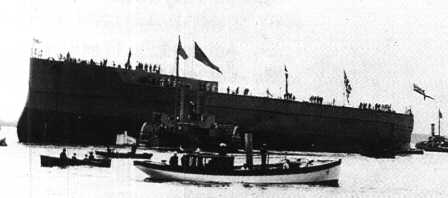 The launch of HMS Dreadnought
The launch of HMS Dreadnought
The Dreadnought was designed wholly around her 305 mm guns, primarily to provide a steady gun platform for them at sea, with masts, funnels and bridge structure placed so as to produce minimum interference with their arcs of fire. Even her new turbine propulsion was designed to increase the effectiveness of her armament, by making her fast enough to overhaul other ships and bring them within range of her big guns. At that moment, she indeed was the fastest battleship afloat. She was harshly criticized by many naval officers and designers who were advocates of the mixed - armament ship and could not conceive a naval battle fought at a range of more than 3000 m. They also thought she was too expensive (� 1,783,883), although that was not much more than her mixed - armament predecessor, the Lord Nelson, still not completed, would cost. The criticism of the Dreadnought finally died away after W.S. Sims wrote an essay in which he once again emphasized the overwhelming advantages which a fleet of "Dreadnoughts" would enjoy over a fleet of mixed - armament ships.
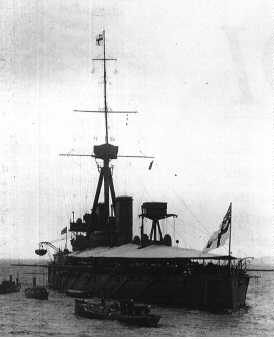 HMS Dreadnought
HMS Dreadnought
Fisher's gamble paid off. Because the Dreadnought was built in great secrecy and record time, it was not until she made her public appearance when she joined the British fleet that the rest of the world's navies knew what they were up against. In appearance, she was awe - inspiring, with an impression of uncompromising efficiency and colossal power, overshadowing every other battleship afloat. All other navies had to stop their battleship building programmes. For Germany, already emerging as a principal challenger to British naval supremacy, it was a particularly severe blow. She had already embarked upon building a series of Deutshland class battleships, 18-knot mixed - armament ships of 13,400 tons, but it would obviously be unwise to complete them, having in mind the British Dreadnought. However, building ships large enough to carry armament comparable to Dreadnought's meant enlarging the Kiel Canal, recently completed, but unable to take ships above 16,000 tons. It also meant enlarging naval dockyards and rebuilding dry - docks. While Germany and the other maritime nations pondered the problems, Britain continued with her building programme, and so kept herself well ahead of the competition.
The Dreadnought served throughout World War I., in 1915. ramming and sinking a German submarine in the North Sea. However, by 1916. she was too slow for first-line service. In 1920. she was sold for scrap, and was broken up in 1921.
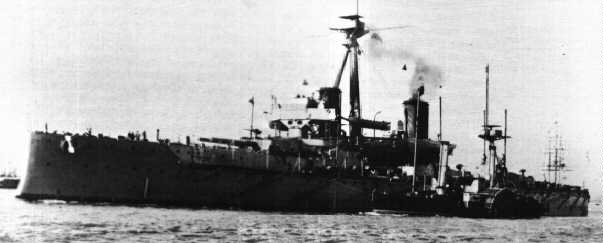 HMS Dreadnought
HMS Dreadnought
H.M.S. Dreadnought marked the beginning of a worldwide revolution in naval design and building. In an official paper which Fisher prepared for the Admiralty he proclaimed "We shall have ten "Dreadnoughts" at sea before a single foreign "Dreadnought" is launched." And his paper was headed: "New Name for the Dreadnought: "The Hard Boiled Egg" Why? Because she can't be beaten."

Challenger 2
by Tomislav Karlovic
Main battle tank presents the core of every army. If it's modern main
battle tank (MBT) like a Challenger, it presents the extreme power in
hands of those who use it.
It's 120mm main gun, high speed and thick armour ensure him the highest
percentage of survivability on the modern battleground.
It weights 62,5 tons and has crew of 4 members, driver, gunner, loader
and commander.
This tank is succesor of well-known Challenger 1 and is also developed
and produced by Vickers Defence Systems Ltd., very famous british
armament industry.
Challenger 2 is now produced for the British Army and for the Royal
Army of Oman. Oman has ordered 18 tanks and 6 support vehicles based on
Challenger 2 chasis,
and the UK Ministry of Defence ordered 386 tanks with certain number
of Challenger Armoured Repair and Recovery Vehicles.
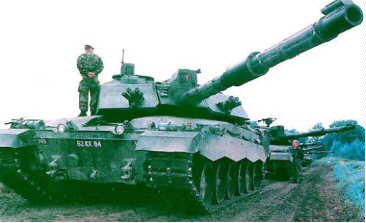
ARMOUR AND ARMAMENTS
The turret is protected with second generation Chobham armour which
provides protection 2 to 3 times better than regular steel armour.
The tank is also protected against nuclear, biological and chemical
(NBC) warfare by an NBC protection system
located in the turret bustle and the electronics are protected against
electromagnetic pulse (EMP).
Challenger's main weapon is L30, 120mm rifled gun produced in Royal
Ordnance division of British Aerospace Defence Ltd. factory in Nottingham.
Weapons construction incorporates chromium lining which provides harder
and smoother internal surface. It also provides better precision,
increased velocity and reduces wear on the barrel. The gun fires all
120mm ammunition. There is capacity for 50 rounds of
APFSDS L26 (Armour Piercing Fin-Stabilised Discarding Sabot), HESH L31
(High Explosive Squash Head) and smoke ammo L34.
The gun also fire The Depleted Uranium (DU) projectiles with increased
penetration. The gun control is provided by an all-electric gun control
and stabilisation system from GEC Marconi Radar and Defence Systems of
Leicester.The tank is also equipped with 7,62mm McDonnell Douglas chain gun
positioned to the left of the main gun.
Other 7,62mm GPMG anti-air gun is mounted on the turret. On each side
of the turret there are 5 L8 smoke grenade dischargers made by Helio
Mirror Company of Kent.
It can also make smoke screen by injecting fuel into the engine
exhausts.
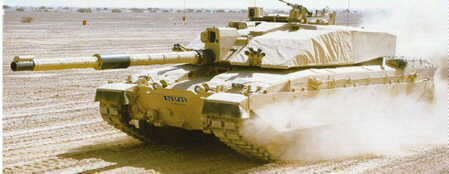
ELECTRONICS
The driver is equipped with a Passive Driving Periscope from Pilkington
Optronics which uses for night driving night vision image intensifier.
The gunner has a stabilised Gunner's Primary Sight, from Pilkington
optronics with laser rangefinder which operates
to the range of 10 km. He is also equipped with a reversionary mode
telescope, L30 from Nanoquest, mounted coaxially with the main gun.
The night vision is provided by TOGS II (Thermal Observation and
Gunnery Sight II) whichs thermal image is displayed both on
gunners and commanders sight. The imager is mounted inside an armoured
barbette above the gun.
The commander has a gyrostabilised site, VS 580-10 from SFIM
Industries, France. The upper unit of VS 580-10,
containing the gyrostabilised panoramic sight and electronics, is
mounted on the turret roof.
Nd:Yag laser rangefinder is incorporated into an intermediate assembly
which joins the upper unit to a lower telescope assembly inside the turret.
The telescope assembly huoses the optical viewing system, hand
controls, electronics and the sight stabilisation system.
All informations are gathered and processed by Military Standard 1553 data bus.

AGILITY
The Challenger 2 is equipped with 1200 hp (882 kw) Perkins Condor V12
diesel engine manufactured by Perkins Engines Ltd., UK,
and David Brown gearbox TN 54. Relatively week engine gives Challenger
2 the 19,2 hp/t ratio on 62,5 tons of weight,
so it was needed to equip export Challengers with the the stronger
engine from MTU, MTU 883 with 1500 hp (1100 kw),
land Renk HSWL 295TM gearbox. The maximum speed on the road is 59 km/h
and 40 km/h outside roads.
Operational radius varies also regarding the terrain from 250 km to 450
km (what is comparing to other modern tanks
lesser than recommended but can satisfy well equipped army like British
with very good organised logistics).
SPECIFICATIONS
Crew: commander, gunner, driver, loader
Weight: 62,5 tons
Length: 11,55 m
Height: 2,49 m
Width: 3,52 m
Engine: Perkins Engines Condor 1200 hp (882 kw)
Max. speed: 65 km/h (test)
Range: 450 km
Main gun: L30 120mm
Ammo: 52 rounds
 |
� � � � |


